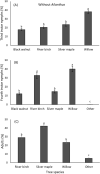Performance and host association of spotted lanternfly (Lycorma delicatula) among common woody ornamentals
- PMID: 34349195
- PMCID: PMC8338946
- DOI: 10.1038/s41598-021-95376-x
Performance and host association of spotted lanternfly (Lycorma delicatula) among common woody ornamentals
Abstract
Lycorma delicatula (spotted lanternfly) has a broad host range with a strong preference for the invasive host plant from its native range, tree of heaven (Ailanthus altissima); it had long been speculated that L. delicatula could not develop or reproduce without access to tree of heaven. In 2019, we found that this assumption was incorrect, but fitness was reduced in the absence of A. altissima in that the number of egg masses laid was dramatically fewer for insects reared on suitable non-A. altissima host plants that had recently been established. We hypothesized that longer established, larger trees (of the same species) would improve the fitness of L. delicatula in the absence of tree of heaven. In spring 2020, we examined insect performance with and without access to A. altissima by tracking development, survival, host tree association and oviposition in large enclosures with trees planted two years prior to the study. Each enclosure included one each of Juglans nigra, Salix babylonica and Acer saccharinum along with either one A. altissima or one Betula nigra; these trees had twice the diameter of the same trees the previous year. We reared nymphs with and without access to A. altissima, released them into the corresponding large enclosures as third instars, and monitored them from early July 2020 through November 2020. We also determined whether lack of access to A. altissima by parents of L. delicatula have any fitness effects on offspring performance. To ensure adequate adult populations for comparing fecundity between treatments, third instars were released into the multi-tree enclosures due to high mortality in earlier instars that occurred in a similar study in 2019. Insect survival was higher and development faster with access to A. altissima. Third and fourth instar nymphs were most frequently observed on A. altissima when it was present, while adults were equally associated with A. saccharinum and A. altissima. In the absence of A. altissima, nymphs were most frequently found on S. babylonica, while adults were most often on A. saccharinum. Females with access to A. altissima deposited nearly 7-fold more egg masses than those without access to A. altissima, which is consistent with the difference in egg mass numbers between the two treatments the previous year; thus, our hypothesis was rejected. The offspring of parents that had been reared without access to A. altissima showed similar survival and development time from egg to adult as offspring from parents that never had access to A. altissima. These findings suggest that managers need to be aware that even in the absence of A. altissima in the landscape, several hardwood host trees can be utilized by L. delicatula to develop and reproduce, but fitness without A. altissima is likely to still be reduced.
© 2021. The Author(s).
Conflict of interest statement
The authors declare no competing interests.
Figures






References
-
- Barringer LE, Donovall LR, Spichiger SE, Lynch D, Henry D. The first New World record of Lycorma delicatula (Insecta: Hemiptera: Fulgoridae) Entomol. News. 2015;125:20–23. doi: 10.3157/021.125.0105. - DOI
-
- Dara SK, Barringer L, Arthurs SP. Lycorma delicatula (Hemiptera: Fulgoridae): A new invasive pest in the United States. J. Integr. Pest Manag. 2015;6:20. doi: 10.1093/jipm/pmv021. - DOI
-
- Jung JM, Jung S, Byeon D, Lee W. Model-based prediction of potential distribution of the invasive insect pest, spotted lanternfly Lycorma delicatula (Hemiptera: Fulgoridae), by using CLIMEX. J. Asia-Pac. Biodivers. 2017;10:532–538. doi: 10.1016/j.japb.2017.07.001. - DOI
-
- Lee D-H, Park Y-L, Leskey TC. A review of biology and management of Lycorma delicatula (Hemiptera: Fulgoridae), an emerging global invasive species. J. Asia-Pac. Entomol. 2019;22:589–596. doi: 10.1016/j.aspen.2019.03.004. - DOI
-
- (NYSIPM) New York State Integrated Pest Management. 2020. Spotted lanternfly. https://nysipm.cornell.edu/environment/invasive-species-exotic-pests/spo.... Accessed 18 January 2021.
Publication types
MeSH terms
LinkOut - more resources
Full Text Sources

